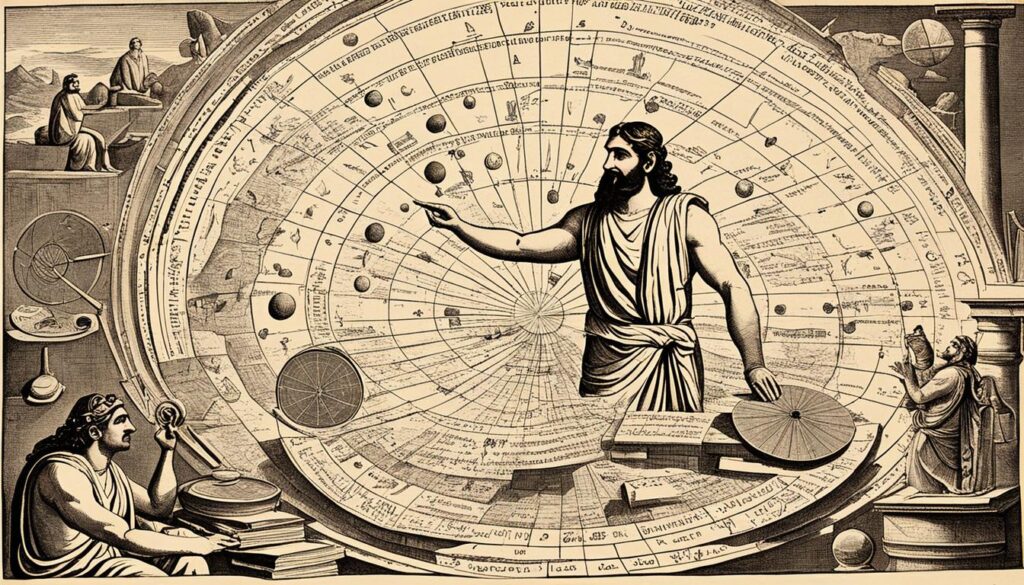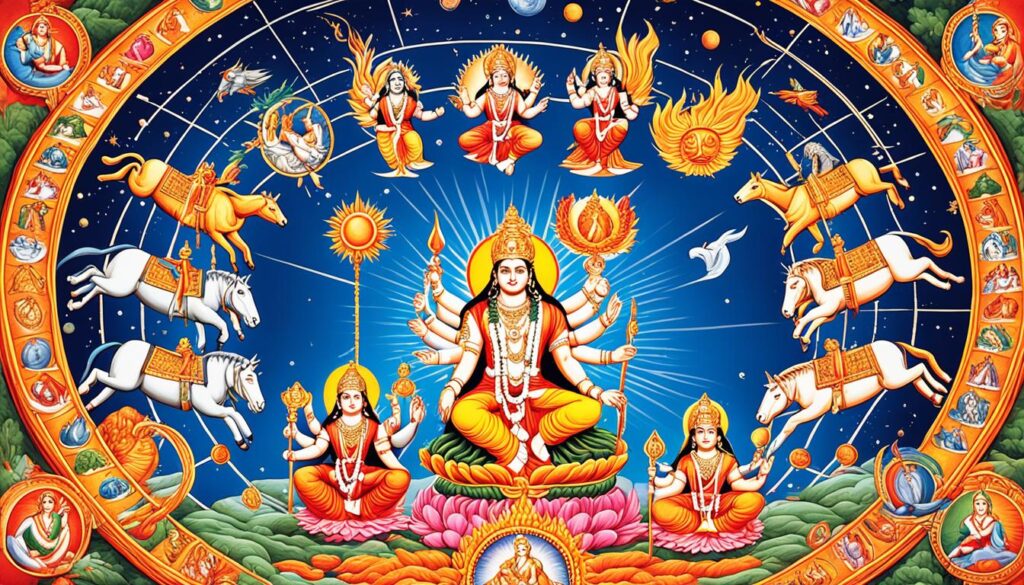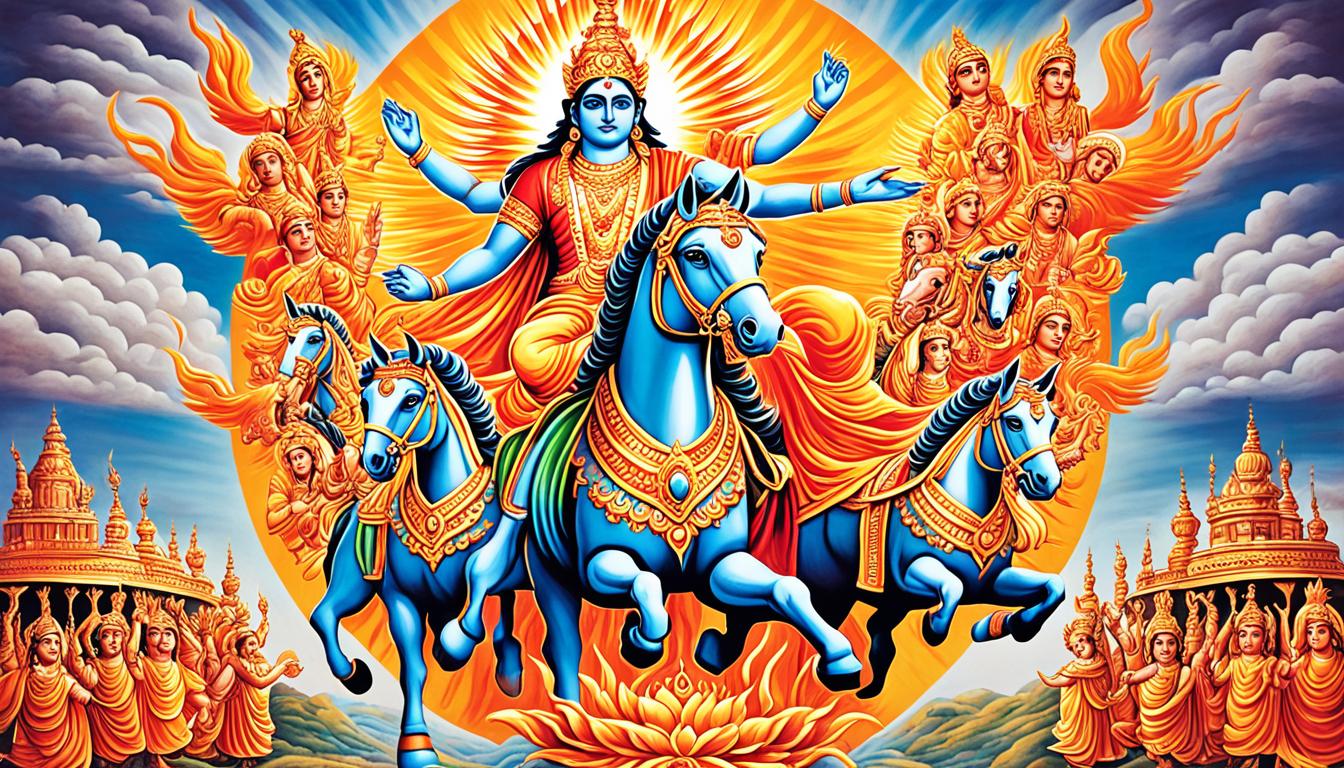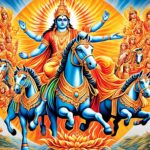Have you ever wondered about the captivating history of astronomy in ancient India? Get ready to discover the celestial wonders that have fascinated the subcontinent for millennia. We will explore the deep meaning of Surya Dev, the revered Hindu sun god.1 This journey will take us from the Vedic era’s sacred texts to the work of classical Indian astronomers.
Key Takeaways
- Surya Dev, the Hindu sun god, is worshipped as the chief deity among the nine classical planets of Hindu antiquity, known as the Navagraha.1
- The Vedic texts, including the Rigveda, contain numerous hymns and devotional writings that worship Surya as a powerful celestial deity.1
- The Surya Siddhanta, a Sanskrit treatise in Indian astronomy, provides detailed information about the motions of planets, the moon, and constellations.2
- Ancient Indian astronomy believed in the geocentric model, where the planets revolved around the Earth, and the Vedic calendar consisted of 12 months, each with 30 days.3 Note: The Indian astronomical tradition stayed active in the medieval period. It also influenced astronomy in other regions, such as the Arab world and Europe.
Get ready for a fascinating journey into the world of Surya Dev and Indian astronomy. What secrets and insights will we find on this celestial adventure? Join me as we explore the wonders together.
Introduction to Surya Dev
Hindus have many gods, each representing parts of life and nature. Among them is Lord Surya, known as the sun god.1 Surya is chief among the nine planets in Hinduism, called the Navagraha.4 He stands for creation and is vital to life.1
The Hindu Sun God
Surya moves across the sky in a golden chariot, bringing light and defeating darkness.4 The goddesses Usha and Pratyusha are sometimes with him. His chariot has seven horses. They represent the seven colors of the rainbow and the seven chakras.4
Significance in Hindu Mythology
The Vedas, ancient texts from 1500-500 BCE, praise Surya. The Rigveda, the oldest Veda, mentions him.1 Surya is seen as the spiritual father of Rama and Karna in ancient stories.4
Symbolism and Representation
Surya has many names like Aditya, Bhanu, and Ravi.4 In the past, people worshiped him with other gods at different parts of the day. This included Brahma, Shiva, and Vishnu.4 Sometimes, Surya is linked with Indra and Ganesha.4 He is also tied to the Simha (Leo) constellation.4
Origins of Indian Astronomy
The start of Indian astronomy dates far back to the time of the Indus Valley Civilization.5 It might even have beginnings before that. Even though we’re not sure how advanced their astronomy was, the Vedic texts began later and talked about sky events here and there.
The Rigveda, which is the oldest Vedic text, brought up things like the change of seasons and a being called Brhaspati, which they might have meant was Jupiter.5 Then, there’s the Vedanga Jyotisha, a key Vedic work. It’s full of notes on what they observed in the sky and how they kept track of time using the sun and the moon.
These Vedic texts also mention “yugas,” huge periods of time. This shows the Indians had a concept of very long time spans. It’s interesting to see this different idea, especially since others, like the Christian and Jewish beliefs, see the universe as a lot younger.
Indus Valley Civilization
The origins of Indian astronomy can be traced back to the Indus Valley Civilization or even earlier. While the exact state of astronomy during the Harappan times is not known, the Vedic texts that followed contain sporadic and desultory references to celestial phenomena.
Vedic Texts and Astronomical References
The Rigveda, the earliest of the Vedic texts, mentions concepts like the return of seasons and the “lord of the prayers” Brhaspati, which may have been an early identification of the planet Jupiter.5 The Vedanga Jyotisha, an ancient astronomical text, is considered the most significant Vedic work on astronomy, containing observational statements and details about the calendrical system, including the use of both the sun and the moon as timekeepers.5 The Vedic texts also introduced the concept of “yugas” or vast stretches of time, reflecting the Indian understanding of deep time, in contrast to the Christian-Judaic view of a much younger universe.
Vedanga Jyotisha: The Vedic Astronomical Treatise
The6 Vedanga Jyotisha is among India’s oldest texts focused on astronomy. It talked about the sun, moon, nakshatras (stars), and how time was measured. This system used the sun and moon. There were 12 months with 30 days, making a year with 360 days.
To make up for the 365-day solar year and the 354-day lunar year difference, two extra months were added every five years. This way, the calendar averaged to match the actual time pretty well, though it still had a small error.
Concept of Yugas
The texts also mentioned “yugas,” which means long periods of time. A Mahayuga was said to be 12,000 divine years or 4,320,000 human years. This idea about time was very different from what the Christian and Jewish religions believed then.
Surya dev in the Vedic Era
Surya is a key figure in the Vedas, Hinduism’s ancient sacred texts. The Rigveda highlights his importance through hymns and prayers. These texts depict Surya as a divine being driving a golden chariot across the sky. He defeats the darkness and spreads light, personifying the sun as a powerful deity. He is closely linked with Brhaspati, believed to represent Jupiter. By emphasizing his unique attributes, the Vedic texts firmly establish Surya’s critical role in Hindu belief and culture.
Hymns and Devotional Writings
7Between 1500 and 1000 BCE, the Rigveda first mentioned Surya. It’s the oldest Vedic text and serves as a key source on Hindu beliefs.1Hymns in the Vedas, written from 1500 to 500 B.C.E., also praise Surya. They center on the Rigveda’s celebration of this majestic deity, enhancing his importance in the Vedic tradition.
Personification of the Sun
4Art often shows Surya in a chariot with seven horses, representing light’s colors and the week’s days.4Later, he was part of worship cycles alongside Brahma, Shiva, and Vishnu, vital gods in Hinduism.4Surya is seen as the father of important figures, tying him closely to Hindu epics and religious stories.4Associating him with Leo, and linking him with other deities, further underlined his importance. This highlights the deep cultural and religious role Surya plays in Hinduism.
1Surya was and remains clearly visible, distinct among Hindu gods. The practice of sun salutations, Surya Namaskar, is a testament to his enduring importance. It represents courage, authority, and vitality according to Vedic astrology.1The Gayatri Mantra, a powerful Vedic hymn, is dedicated to Surya. Invoking this mantra nourishes his worship in Hinduism, with devotees performing pilgrimages and festivals dedicated to him.
Influence of Greek Astronomy

Indian astronomy changed a lot in the 4th century BCE. This change came after Alexander the Great’s conquests.5 Indo-Greek astronomy started appearing in texts by the Common Era. These texts, like the Yavanajataka and Romaka Siddhanta, mixed ideas from both cultures.5
Yavanajataka and Romaka Siddhanta
Yavanajataka took Greek ideas and wrote them in Sanskrit. Romaka Siddhanta translated Greek astronomy into Sanskrit.5 This sharing brought Greek principles, like models for planetary motion, into Indian astronomy. Later, these ideas spread to the Arab world and Europe.2
Synthesis of Indian and Greek Knowledge
Indian and Greek astronomy blended in the Surya Siddhanta, written between the 4th and 5th century.2 When it was revised in 800 CE, it mentioned the Earth as a still sphere orbited by the Sun. This is similar to Hellenistic astronomy.2 The exchange of ideas between these two cultures put a lasting mark on the study of the stars worldwide.5
Classical Era and Astronomical Advances
In the 5th to 6th centuries, Indian astronomy reached new heights thanks to great minds.5 Aryabhata was at the forefront with his work. He delved into units of time and ways to find where planets are. He also explained why we have day and night and other big ideas about the universe.5
Brahmagupta built on Aryabhata’s foundation. In his books, he added more, like how planets move instantly and better ways to predict eclipses.5 Varahamihira brought together ideas from India, Greece, Egypt, and Rome in his book Pancasiddhantika. This showed how knowledge was shared and blended during that time.
Aryabhata and the Aryabhatiya
Aryabhata was a key figure in ancient Indian astronomy.5 He wrote the Āryabhatīya and Āryabhaṭasiddhānta. These works were popular in the northwest of India and influenced Islamic astronomy. His works include how to find where planets are, why we have eclipses, and that the Earth spins.
Brahmagupta and the Brahmasphutasiddhanta
5 Brahmagupta’s Brāhmasphuṭasiddhānta greatly influenced Islamic astronomy and math. He brought new ideas, such as the way planets move instantly, and better ways to forecast eclipses.
Varahamihira and the Pancasiddhantika
Varahamihira connected the dots between Indian, Greek, Egyptian, and Roman astronomy in Pancasiddhantika.5 His book represents a peak in Indian astronomy, showing how different traditions came together. This was a time of great learning and sharing in the field.
Astronomical Observatories and Instruments
In India, the growth of astronomy got a big boost from building many observatories and using special instruments.5 A great example is the Jantar Mantar, crafted in the 18th century by Jai Singh II, a Rajput king. It includes big masonry tools like sundials and quadrants. These helped make precise readings of the sky’s movements.5
Jantar Mantar
The Jantar Mantar is found in various Indian cities. It reflects India’s deep astronomical roots.5 At these grand sites, you’ll see devices to watch the sun, moon, and stars closely. This enabled them to predict big celestial happenings accurately.5
Other Observatories
Besides the Jantar Mantar, many other observatories marked India’s interest and progress in astronomy.5 Outfitted with advanced astronomical instruments, they were key in expanding our knowledge of space and the stars.5
| Observatory | Location | Notable Features |
|---|---|---|
| Jantar Mantar | Delhi, Jaipur, Ujjain, Mathura, Varanasi | Large-scale masonry instruments for observing celestial bodies |
| Kerala School of Astronomy and Mathematics | Kerala | Prominent in the medieval period, contributed to advancements in astronomy and mathematics |
| Madras Observatory | Chennai | Established in the 19th century, focused on meridian observations and time-keeping |
Surya Dev in Rituals and Festivals
The Hindu sun god, Surya, is a key figure in Hinduism’s rituals and festivals.4 He’s one of the five main deities in the Smarta tradition.4 This tradition shows him riding a chariot with seven horses. These horses symbolize visible light’s seven colors and the week’s seven days.4 By the medieval times, Surya’s worship was part of daily prayers. Brahma in the morning, Shiva at noon, and Vishnu in the evening.4
Surya Namaskar (Sun Salutations)
1 Among the nine planets in Hindu belief, Surya shines.1 He’s very important in yoga, especially in the Surya Namaskar poses.1 The Gayatri Mantra praises Surya and is seen as very powerful.1
Festivals and Celebrations
8 Ratha Saptami is the festival for Sun God Surya dev, celebrated on the seventh day of the month of Magha. This usually falls in January or February.8 It’s a joyful time for Hindus all over India, marking Surya bhagwan’s (Sun God) birth.8 To mark this special day, sun wall hangings are used, made of different materials and designs.8 Festivities include Sun God prayers, holy dips, and the Surya Namaskar. In some places, people fast until sunset as part of the celebration.8 Lord Ganesha decorations are also common during this time.8 Religious art, like paintings and posters, helps make the festival feel sacred. Such art often includes the Sun God’s chariot pulled by seven symbolic horses. This symbolizes the rainbow’s colors and the week’s days.8 The festival’s highlight is a parade where people pull the Sun God’s chariot through the streets. The chariot is beautifully decorated, and blessings are asked for.8
Importance of Surya Dev in Astrology

Surya is a key figure in Hindu astrology – Jyotish.1 He is the main of the nine planets in Hindu astrology, the Navagraha.1 In Hindu astrology, Surya is seen as the sun. He is celebrated as a god who creates and sustains life.1
Navagraha and the Nine Planets
Surya’s position, along with the other Navagraha, greatly impacts astrology.9 In Vedic astrology, the Sun rules over all planets.9 Only the Sun and Moon own a single zodiac sign each. All other planets (except Rahu-Ketu) have two signs.9 The Sun is seen as the highest among the nine planets.9
Astrological Implications
Belief in Surya’s power and the Sun’s role in astrology is fundamental in Hinduism. It remains key to Indian culture and spirituality.9 Where the Sun appears in a horoscope influences many life areas. This might include bravery, self-esteem, wealth, and wisdom according to Vedic astrology.9 Surya is linked with Leo. He gets along with Jupiter, Mercury, and Mars, and is neutral towards the Moon and Ketu. Yet, he considers Venus and Rahu as enemies.9
Conclusion
The story of Indian astronomy is deeply rich. It shows the strong love and wonder for space in India. This comes from the time of the Vedic era’s astronomical references to the works of people like Aryabhata, Brahmagupta, and Varahamihira. These scholars in classical times made key discoveries. They added a lot to how we see the stars and space.10
Indian astronomers did more than just stargazing. They built observatories and used special tools. They also connected space with their culture and spiritual beliefs. For them, Surya Dev, the sun god, is more than just a god of light. He stands for life and the divine. This shows how deeply Indian astronomy is woven into their history and future.1011
The use of natural language processing can help us learn more. It has many uses, like making AI chatbots and conversational AI smarter. It’s also good for understanding old texts about the stars. With it, we might find new clues and learn even more from the astronomical traditions of India.1011
FAQ
What is the significance of Surya Dev, the Hindu sun god, in Indian astronomy?
Surya Dev holds a key position in Indian astronomy’s rich history. He stands as the leader among the nine planets in Navagraha. His influence is at the core of Hindu beliefs and astrological customs.
How did the Vedanga Jyotisha contribute to the development of Indian astronomical knowledge?
Vedanga Jyotisha, an ancient Indian astronomical text, covered the sun, moon, nakshatras, and the lunisolar calendar from the Vedic period.
What was the impact of Greek astronomy on the Indian astronomical tradition?
Greek astronomy’s ideas were merged with Indian knowledge starting from the 4th century BCE. This mix is apparent in works like the Yavanajataka and Romaka Siddhanta.
Who were the prominent astronomers during the classical era of Indian astronomy?
In the classical era, from the 5th to 6th centuries, stellar figures like Aryabhata, Brahmagupta, and Varahamihira made huge strides. They improved our understanding of planetary orbits, eclipse predictions, and mixed various astronomical stands.
How did the construction of observatories and the development of astronomical instruments contribute to the advancement of Indian astronomy?
Building observatories like the Jantar Mantar and using cutting-edge instruments was vital. It helped with precise observations of stars and planets. This showed India’s sophisticated astronomical studies over the years.
What is the significance of Surya Dev in Hindu rituals, festivals, and astrological practices?
Surya Dev plays a central role in Hindu customs and celebrations like Surya Namaskar, Makar Sankranti, and Chhath Puja. He’s also key in Hindu astrology, or Jyotish. The sun and other planets are thought to hugely impact our lives.
Source Links
- https://study.com/academy/lesson/surya-hinduism-worship-facts-sun-god.html
- https://en.wikipedia.org/wiki/Surya_Siddhanta
- https://www.hindujagruti.org/history/32070.html
- https://en.wikipedia.org/wiki/Surya
- https://en.wikipedia.org/wiki/Indian_astronomy
- https://en.wikipedia.org/wiki/Hindu_astrology
- https://www.worldhistory.org/Surya/
- https://www.ecraftindia.com/blogs/articles/ratha-saptami-significance-rituals-celebrating-the-festival-of-chariots
- https://www.timesnownews.com/astrology/cosmic/know-the-significance-of-the-sun-among-the-navagrahas-article-109351882
- https://pujayagna.com/blogs/hindu-gods-goddesses/lord-surya-sun-god
- https://www.jagatgururampalji.org/en/hindu-deities/is-surya-dev-a-fireball-or-hindu-lord-true-profile-revealed/

